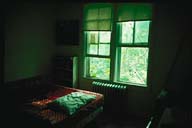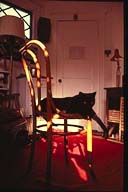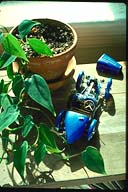![]()
I used to be an art historian for a living, and I had to learn to take my own slides. I had used cameras since I had been a teenager anyway, having borrowed my oldest brother's Leica when I was too young to be trusted with it. As an art historian, I worked a lot in museums, so I continued to use a small 35mm camera, but I switched to a SLR, and I got used to working with natural light.
I liked taking pictures, but not 'making pictures.' I never had a darkroom, so I used commercial processors and kind of enjoyed seeing how things came out. For a while, I shot in repackaged 'cinema' film, which had a lot of latitude for color temperature and intensity, but could still capture good detail, even in shadow. This type of film always had to be processed mailorder, usually at the same cinema lab that packaged it. The lab could return prints, negatives, slides or any combination. Since I was used to slides from my art history classes, I tended to get that format the most.
Over the 1970's I assembled a small group of pictures I thought were my best. I even exhibited some of them. Mostly, however, I just kept re-using them in new formats. I would send those slides out to get large prints made using various techniques and chemistries, and I even had some made into black and white posters, which I used to decorate my apartment. I had one or two made into half-tone engravings, which I could use in my printing press (another story.) Lots of variations; lots of fun.
Then came computers, and then Kodak came out with the PhotoCD, and I had a bunch of those favorite slides transferred onto a PhotoCD. That format has languished, now, but it still has its merits. And I still have the PhotoCD.
So here we are on the World Wide Web, and it's just another source of endless variation to these pictures. On this page I've converted a selection into JPEG for thumbnails, and used PNG for the larger scales. You'll probably need a plug-in for that format, but it's widely available. These formats get sent to your browser, which in turn uses its own motley color 'palette', and then they'll be represented in whatever resolution by your digital or analog video card and monitor. Makes your head spin, doesn't it?
There is a native PCD viewing system for the web, relying on a set of Java applets and a CGI driver. It is based a group of Java class files and two executables. One of the executables is a small c program that I have managed to compile, but the other is a precompiled executable that extracts JPEGs from the native PCD files. There's, no source, and it seems to break when I test it from the command line. Of course, the mailing list for the software is dead, and so help from Kodak is out of the question.
The end results of the PCD software, when it works, is still just a JPEG, but since it gets created on the fly with parameters which can be scripted, it's versatile, and it saves the time and diskspace required to 'prepare' converted files. And when it works, it offers a live, scrollable viewing window in any size, with zooming controls and other goodies. So it is interesting, but alas, it does not work [yet] on this system.
Here are a few of my favorite pictures in a rather more simple presentation: a list of small JPEG images, which you can click on for a 512 X 768 PNG file which will open in a separate window.
These images remain under my copyright. You may download them for viewing, but you may not copy or re-use them in any way without my permission.

I taught for a while at Niagara County Community College in Niagara Falls New York. At that time it was housed in a collection of buildings near the falls, including the remnants of the old Nabisco Shredded Wheat Factory. My apartment was downtown, near the railroad bridge to Canada, in what was described to me as the oldest remaining commercial building in town. It had a bar on the first floor, a couple of apartments on the second, and a ballroom on the third.
This was my first job after graduate school and I was acquiring my first 'stuff.' I still own and even occasionally use the turntable. The photo was one of several interior shots I had 'blown up' into large black and white posters, and used to decorate the place. I still have the poster, too.

Another interior from my Niagara Falls apartment. Some of the furniture was the landlady's; some my own. I bought some of the furniture when I finally moved out, but not this chair.
This photograph captures the sunlight through one of the three enormous windows that faced the street, and the day. The place had very high ceilings, lots of interesting angles, and I would sit around and watch the light move through the space, wanting to make a movie of it all.

I taught for a while at The Western College in Oxford Ohio. It's now defunct. Many of my best photographs were made while I was there. I was on the art history faculty and hung around the artists. I guess I was inspired.
My second year there I lived on campus in a ramshackle structure which was left-over military housing from WWII converted into faculty quarters. This was my bathroom.

This was one of many many shots I took of a traveling carnival setting up on the town common on an overcast day. This red box contained the electrical power connections for one of the rides.

Another shot at the carnival. I loved the way the sky came out on the cinema film emulsion. I hope it looks OK on your monitor.

Shot at The Western College. I'd owned this lamp for a couple of years. Bought it in Niagara Falls.

Back in faculty housing: my bedroom, my sheets, my pillow, the light through my window. The place was on the edge of campus, on the second floor, and all the windows opened onto wild, wooded views. It was like being perched in the forest. I liked it.

My friend invited Dorothy and I to visit his place in Maine. This was the living room of the house he had recently bought.

Dorothy working on her crochet in the kitchen of my friend's house.

Shot in our first apartment in Salem, after The Western College closed and Dorothy and I moved in together. Her radio, my toothpowder. You can't get Dr. Lyons' toothpowder anymore.

I set up a room in Salem as an office and also kept my printing press there. We had acquired a wonderful cat, Flash, seen here on a chair rescued from the demise of The Western College.
We both liked the light.

I made plastic models for a while, but I was terrible at it. I grew lots of plants after the wife of one of my friends in Ohio had given me a plant. So this is a still life.
When Enzo Bugatti died I cut out his obituary, and put it up on my wall. That started me collecting obituaries. I still have his, but the model is gone.
I don't remember where this was taken.
![]()
![]()
This document maintained by
rgm at fabbnet.net.
Material
Copyright © 2000.